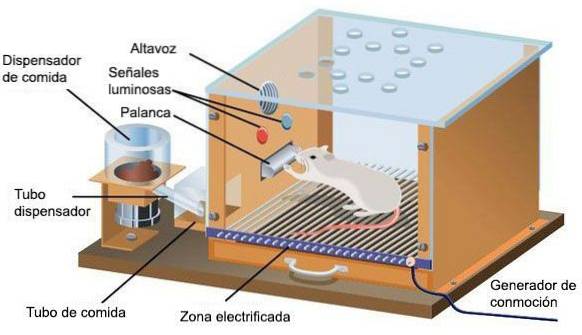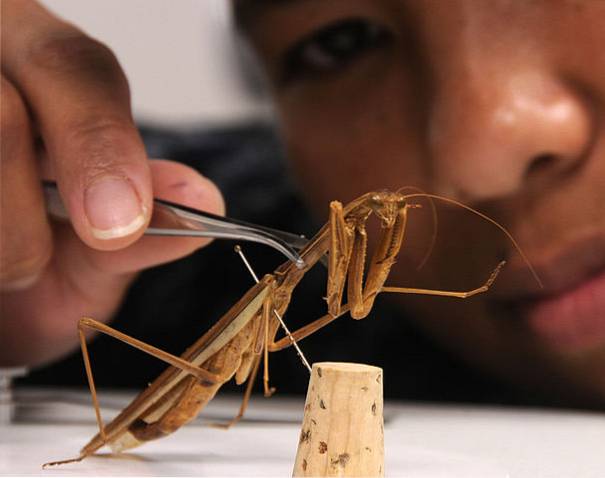
Skinner and in Operant Conditioning
In 1938 BF Skinner, in an attempt to measure and objectify the instrumental response as much as possible and, at the same time, to free it from mentalistic terms (such as satisfactory or annoying consequences) employed by Thorndike, restated the law of effect and reformulated it as law of reinforcement.
According to the law of reinforcement, organisms learn new behaviors that are followed by reinforcement; and we know that they have been reinforced because it increases the probability that these behaviors will reappear in the future.
Contents
- Skinner's box
- The Operant Conditioning process
- Deprivation
- Adaptation to the cage
- Food dispenser training
- Modeling by differential reinforcement or successive approximations
- Bibliography
Skinner's box
Skinner materialized the demonstration of the law of reinforcement by establishing the operant conditioning process with the cage designed by himself and called Skinner's box..
The term operant conditioning refers to the process by which the frequency of presentation of a behavior is modified by its consequences. Thus, the probability of the appearance of an operant behavior is determined mainly by the events that happened after carrying out this behavior in the past. Skinner introduced the term operant behavior to define all those responses that have the same effect on the environment. In this sense, the operant behavior of pressing the lever can be executed by a rat making different responses, such as, for example, pressing with a paw, with the nose or with the tail. All these responses constitute the same operand.

This device allowed an animal such as a rat (he also used pigeons as experimental subjects) to learn an arbitrary behavior such as pressing a lever, provided that the performance of this behavior was followed by the immediate presentation of food that would reinforce this operant behavior. The Skinner designed box is based on the following elements:
- A lever located inside the cage that the animal has to press to obtain food and that is automatically connected to the mechanism that dispenses the small ball of food that will fall into the feeder located next to the lever..
- A cumulative recording mechanism that graphically shows when and how often the animal responds during the session.
The Operant Conditioning process
A typical operant conditioning procedure consists of the following steps:
Deprivation
It is about depriving the rat that will be conditioned from eating, until it is at 80% of its usual weight, that is, until it reaches a reduction of 20% in its weight.
Adaptation to the cage
During the adaptation sessions, the animal is placed inside the cage to habituate the typical exploration responses of the rat and to observe, also, what is the initial operating level of the animal; that is, how often do you hit the lever before you start conditioning this response. This operating baseline will serve as a reference to verify the subsequent increase in the response rate caused by the presence of the reinforcement..
Food dispenser training
This phase has a double objective: on the one hand, that the animal knows where the food will appear and, on the other, that it learns, by classical conditioning, to associate the noise of the food-dispensing mechanism (sound that will become a conditioned stimulus or signaling the presence of food) with the availability of food in the manger.
Modeling by differential reinforcement or successive approximations
It is in this phase that the animal learns the operant behavior of pressing the lever; To achieve this, each time the animal makes a movement that is part of or brings it closer to the final behavior, it will receive food. Thus, for example, the reinforcement will be presented only when the following behaviors appear: first, it will be reinforced that the rat is oriented towards the lever; later, when it gets closer; later, when you lift the legs above the lever; and, finally, when you make the proper pressure on the lever.
The modeling technique for differential reinforcement is used to increase the probability of the appearance of a behavior that is practically non-existent in the normal repertoire of the organism, but that it does not present any physical limitation to be able to execute. This technique requires planning and sequencing, in increasing order of difficulty, of the different steps that must be achieved to reach the final target behavior, to administer the reinforcement only after each of these previous behaviors. Thus, it can be used both to teach a rat to press a lever, to teach a pigeon to play the piano or to train a blind man's guide dog. However, modeling is especially useful for teaching complex behaviors to children (which would naturally be difficult for them to occur) or to people with intellectual disabilities. This technique is also at the basis of different behavioral therapies, such as the so-called systematic desensitization used to get the person to get closer to the object or situation that initially provokes aversion..
To assess the strength of operant conditioning, Skinner continuously measured the frequency or rate of response with which the rat squeezed the lever. This experimental method designed by Skinner calls free operant, since the animals can freely repeat, as many times as they want, the instrumental response without requiring the participation of the researcher. The free operand method is opposed to the trial by trial method, initially used by Thorndike, since in this method it is the same experimenter who marks the beginning of each trial; thus, direct manipulation of the animal is necessary to place it back in the experimental chamber once the instrumental behavior has been carried out.
The operant conditioning procedure initiated and developed by Skinner enabled him to predict and control behavior. This knowledge has been essential in different fields of psychology: thus, they have had repercussions, mainly, in the clinical field or behavior therapies, in the field of teaching and in social aspects.
Bibliography
A.B. Sulzer i M.G. Roy (1983). Behavioral analysis procedures applied with children and young people. Mexico: Threshing.
D.L. Whaley i R.W. Malott (1983). Behavioral psychology. Barcelona: Fontanella.



Yet No Comments